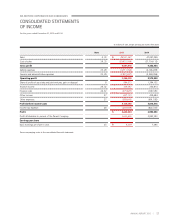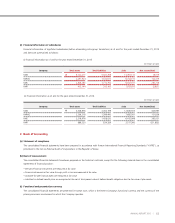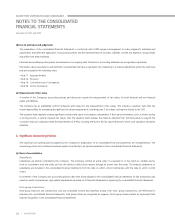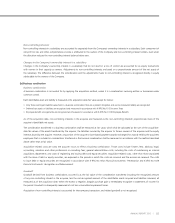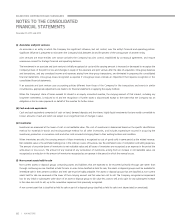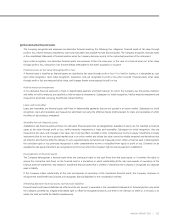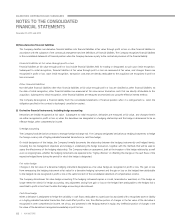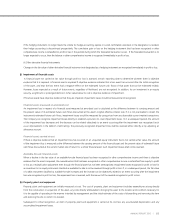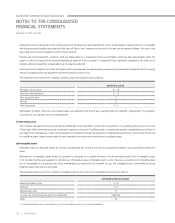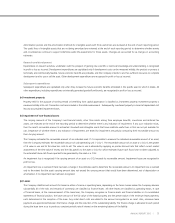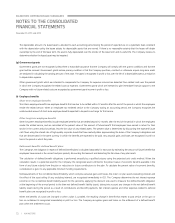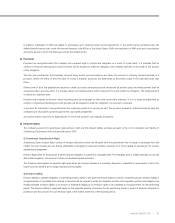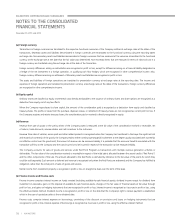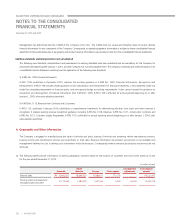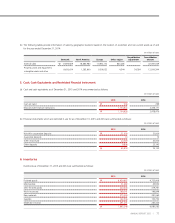Kia 2015 Annual Report Download - page 73
Download and view the complete annual report
Please find page 73 of the 2015 Kia annual report below. You can navigate through the pages in the report by either clicking on the pages listed below, or by using the keyword search tool below to find specific information within the annual report.
(g) Non-derivative financial assets
The Company recognizes and measures non-derivative financial assets by the following four categories: financial assets at fair value through
profit or loss, held-to-maturity investments, loans and receivables and available-for-sale financial assets. The Company recognizes financial assets
in the consolidated statements of financial position when the Company becomes a party to the contractual provisions of the instrument.
Upon initial recognition, non-derivative financial assets are measured at their fair value plus, in the case of a financial asset not at fair value
through profit or loss, transaction costs that are directly attributable to the asset’s acquisition or issuance.
Financial assets at fair value through profit or loss
A financial asset is classified as financial assets are classified at fair value through profit or loss if it is held for trading or is designated as such
upon initial recognition. Upon initial recognition, transaction costs are recognized in profit or loss when incurred. Financial assets at fair value
through profit or loss are measured at fair value, and changes therein are recognized in profit or loss.
Held-to-maturity investments
A non-derivative financial asset with a fixed or determinable payment and fixed maturity, for which the Company has the positive intention
and ability to hold to maturity, are classified as held-to-maturity investments. Subsequent to initial recognition, held-to-maturity investments are
measured at amortized cost using the effective interest method.
Loans and receivables
Loans and receivables are financial assets with fixed or determinable payments that are not quoted in an active market. Subsequent to initial
recognition, loans and receivables are measured at amortized cost using the effective interest method except for loans and receivables of which
the effect of discounting is immaterial.
Available-for-sale financial assets
Available-for-sale financial assets are those non-derivative financial assets that are designated as available-for-sale or are not classified as financial
assets at fair value through profit or loss, held-to-maturity investments or loans and receivables. Subsequent to initial recognition, they are
measured at fair value, with changes in fair value, net of any tax effect, recorded in other comprehensive income in equity. Investments in equity
instruments that do not have a quoted market price in an active market and whose fair value cannot be reliably measured and derivatives that
are linked to and must be settled by delivery of such unquoted equity instruments are measured at cost. When a financial asset is derecognized,
the cumulative gain or loss previously recognized in other comprehensive income is reclassified from equity to profit or loss. Dividends on an
available-for-sale equity instrument are recognized in profit or loss when the Company’s right to receive payment is established.
Derecognition of financial assets
The Company derecognizes a financial asset when the contractual rights to the cash flows from the asset expire, or it transfers the rights to
receive the contractual cash flows on the financial asset in a transaction in which substantially all the risks and rewards of ownership of the
financial asset are transferred. Any interest in transferred financial assets that is created or retained by the Company is recognized as a separate
asset or liability.
If the Company retains substantially all the risks and rewards of ownership of the transferred financial assets, the Company continues to
recognize the transferred financial assets and recognizes financial liabilities for the consideration received.
Offsetting between financial assets and financial liabilities
Financial assets and financial liabilities are offset and the net amount is presented in the consolidated statements of financial position only when
the Company currently has a legally enforceable right to offset the recognized amounts, and there is the intention to settle on a net basis or to
realize the asset and settle the liability simultaneously.
67
ANNUAL REPORT 2015 |


